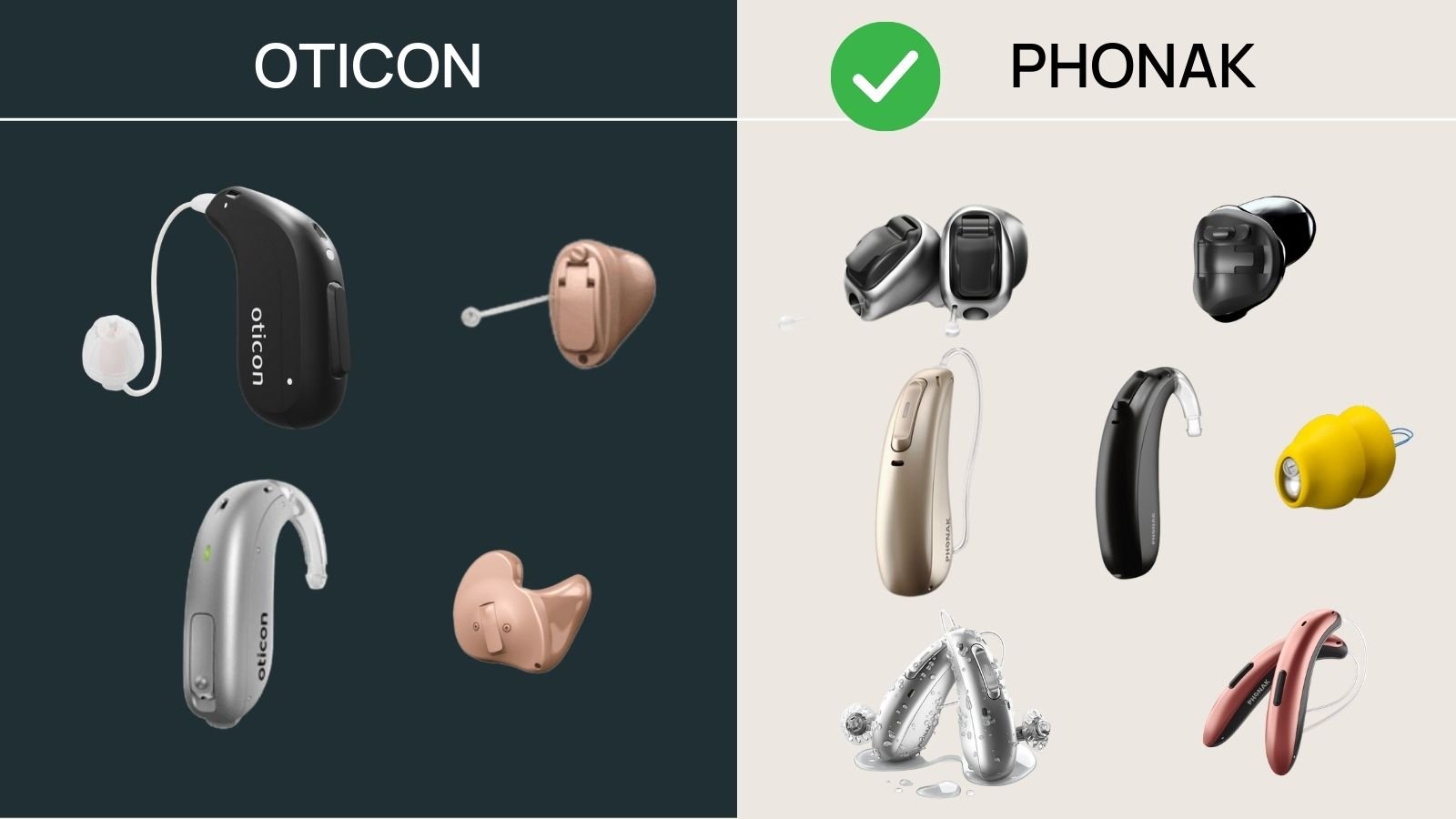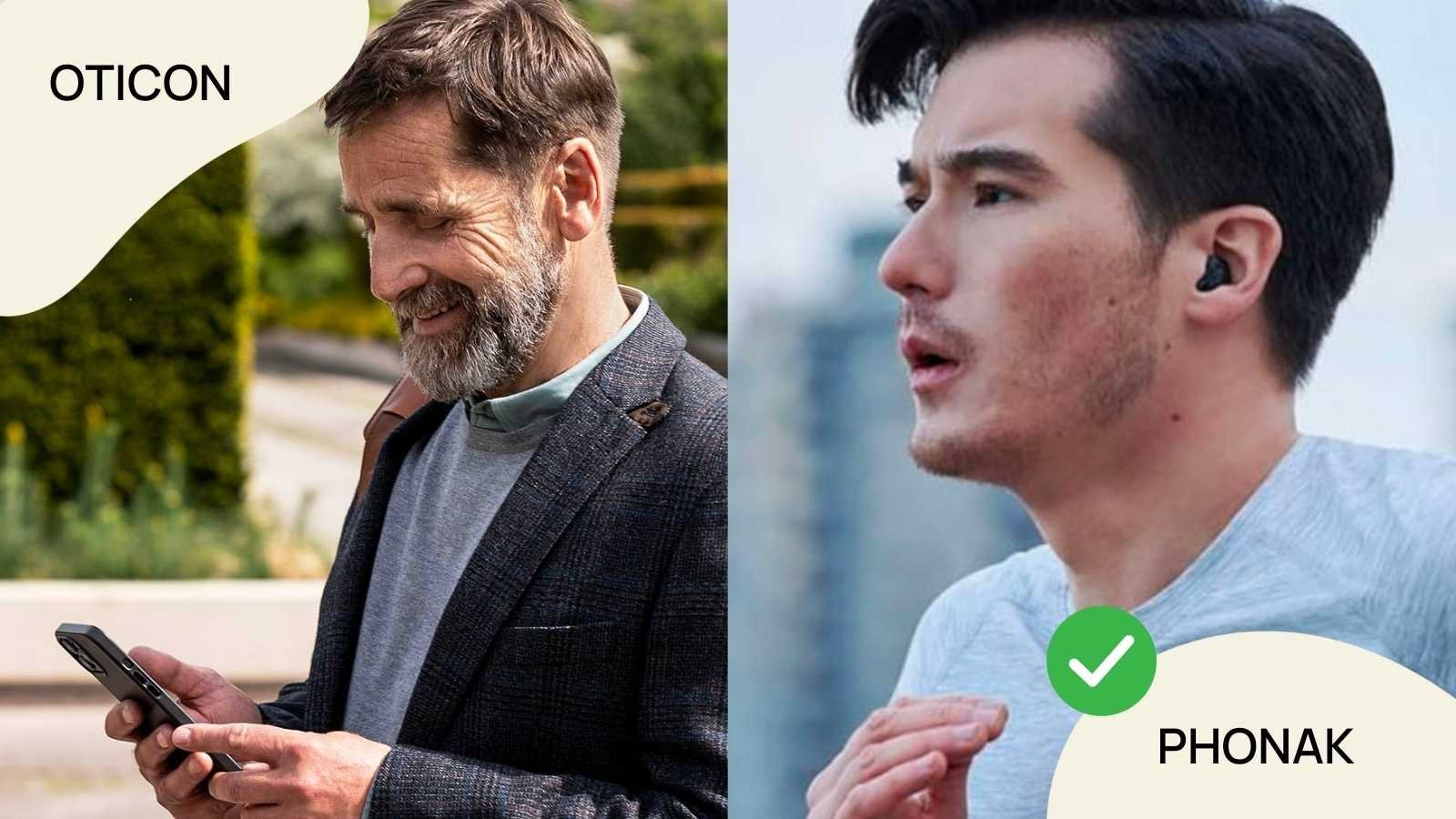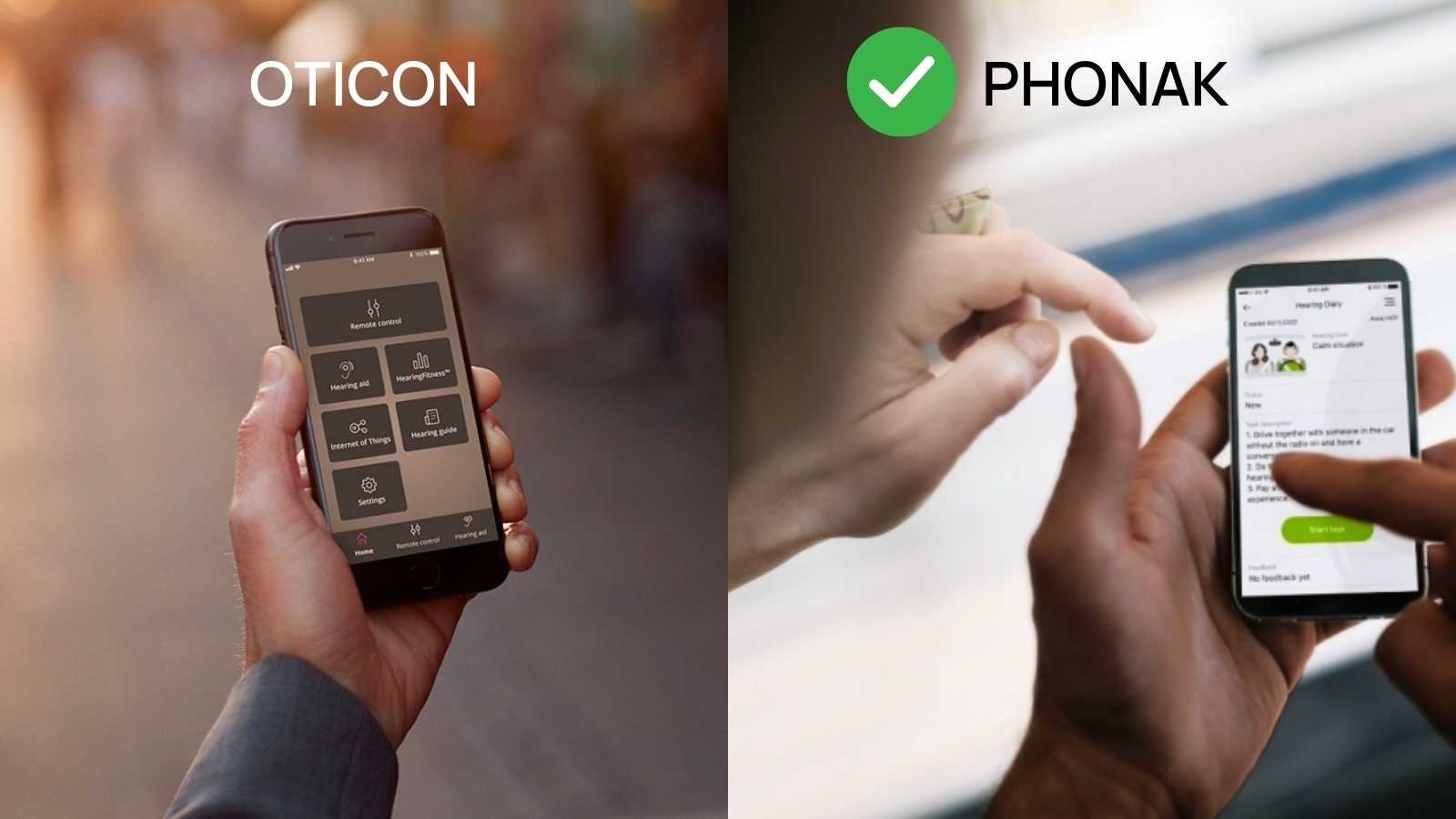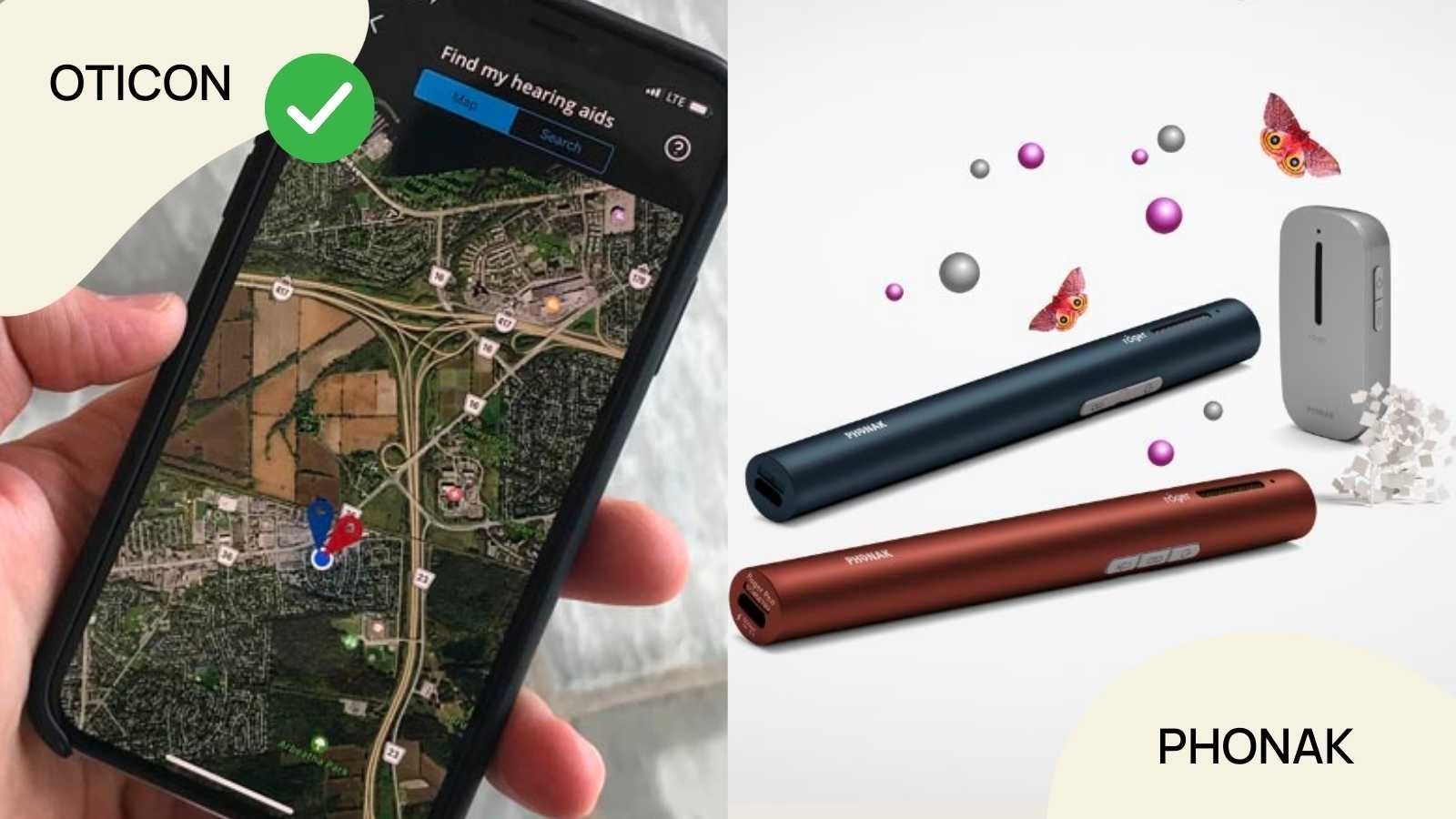Key Takeaways:
- In the style category, Phonak wins big points for its invisible Lyric hearing aid.
- Head-to-head in the Bluetooth round, is a close one. Phonak is the most compatible among Android phones, while Oticon Intent delivers future-forward Auracast technology.
- In Smartphone apps, Phonak wins with its customization options while Oticon keeps it simple.
- When it comes to stand out features, we love Oticon's "Find My Hearing Aids" app feature for piece of mind. Phonak's Roger mics are pretty great, too.
- Finally, Oticon's sound quality is very highly rated and wins the sound quality round.

If you’ve spent much time on this site, you’ll know that we spend hundreds of hours a month reviewing the best (and worst) hearing aids on the market.
I’ve tried more than 30 pairs, from Eargo’s invisible hearing aids to ReSound’s top-of-the-line products and an $999 pair from Bose. Click around this site, and you’ll find guides to our favorite hearing aids across prices and styles.
Today we’re going to do something a little different. Instead of a well-rounded list of options, I’m going to compare just two hearing aids in a “head-to-head” style matchup.
I’ll compare the world’s most popular hearing aid from Phonak to the second most popular hearing aid from Oticon. It’s the Yankees vs. the Red Sox, BMW vs. Mercedes, Walmart vs. Amazon… I digress.
Like any iconic matchup, you might not like the results, and you’re entitled to throw a pillow at the screen if you think I get it wrong.
Head-to-Head Rules:
This matchup will go five rounds, with a winner in each category.
Round One | Styles - Shapes, sizes, and design.
Round Two | Bluetooth Connection - Phone calls, podcasts, U2 mixtapes.
Round Three | App Controls - The power is in your hands now.
Round Four | Special Features - Got any tricks up your sleeve?
Round Five | Sound Quality - Seriously, though, this one matters.
A few notes before we begin.
You might notice that price and care aren’t mentioned in the criteria above. That’s because Oticon and Phonak are only available through licensed professionals and offer roughly the same prices.
A comparison on this front would just be boring. I don’t watch soccer because who wants to see a tie?
How to find care: You can search here to find a care provider near you. You can also work with a care network to get lower pre-negotiated prices on both brands (see below).
Prices: Oticon and Phonak hearing aids are around the same price. You can expect to be $5,000-$7,000 if you walk in to a local clinic or $2,798 - $4,598 (depending on tech level) if you work with a care network.
Our Favorite Local Clinic Network
- ZipHearing pairs you with a local clinic at pre-negotiated prices
- Offers top brands like Phonak, Widex, Signia, Oticon, Starkey and ReSound
- Best for folks who are looking for lower prices on prescription products
- Prices from $2,500-$5,000 for a pair of hearing aids with local clinic care
Round One - Styles

Oticon and Phonak both offer flagship receiver-in-canal products. I think both products look sleek and are a similar size. If you decide to go with a standard style that sits behind the ear, this round will be a toss-up. If you forced me to pick one, I might give the style edge to Oticon.
It’s the diversity of the line where Phonak takes a clear lead. Phonak offers waterproof and truly invisible styles, and not to mention their pretty incredible (and newest hearing aid) Phonak Infinio Sphere. Phonak’s invisible Lyric product is especially unique (read our Lyric review here). Phonak also has a titanium-based invisible product that gets rave reviews.
Round One Winner: Phonak ✅
Round Two - Bluetooth Connection

If you use a Smartphone to stream podcasts, music, or phone calls, you’ll probably want to know how the Bluetooth streaming capabilities of these two products match up.
Oticon and Phonak offer Bluetooth streaming from iOS and Android devices, but the brands use two different engineering approaches.
Oticon Intent now offers Bluetooth LE and is Auracast ready. That means Oticon is future-proofed for novel Bluetooth experiences that could roll out in the next few years.
Phonak uses Bluetooth Classic, which provides a more stable connection and connects to a broader range of devices.
This one is a toss up. Oticon's Bluetooth LE is more futuristic, while Phonak's Bluetooth Classic is more widely compatible with a wide range of devices. Still, most professionals agree that Phonak has the best Bluetooth streaming capabilities in the market in 2024. The brand even released a receiver (called ActiveVent) that enhances streaming sound quality.
Round Two Winner: Phonak ✅✅
Round Three - App Controls

Oticon and Phonak both have award-winning apps that allow users to adjust the volume and program of their hearing aids. The Phonak app allows more tinkering and automatically switches between pre-set programs. In contrast, the Oticon app is simpler, with fewer fine-tuning options for hearing aid wearers.
Note that both hearing aids allow a professional to precisely customize the device to your hearing loss.
I debated which brand should win this round but…here goes.
Round Three Winner: Phonak ✅✅✅
Round Four - Special Features

Both Phonak and Oticon have rechargeable batteries, Bluetooth streaming, and background noise algorithms. There are a few features that are unique to each brand.
Oticon has a built-in “find my hearing aid” feature in their app that lets you track down the location of a device if you’ve lost it in your home or on the go. There’s nothing worse than losing your hearing aid, so I love this feature.
Phonak offers an innovative line of external microphones called Roger Mics. People love these sleek devices, and the Roger Pen feels modern and convenient.
I’m giving this round to Oticon. The ability to find a lost hearing aid sounds simple, but it puts my mind at ease.
Round Four Winner: Oticon ✅
Round Five - Sound Quality

We saved the knockout round for last.
Bluetooth, form factor and special features pale compared to one big thing. Sound quality.
The term sound quality is very subjective. It’s like measuring the “feel” of a luxury car. But this wouldn’t be a true head-to-head match-up without a winner. So let’s look at what we know:
Oticon Intent built their sound algorithm using 12M everyday sounds gathered using spherical microphones around the world. Oticon uses all of that data to form an algorithm for handling background noise. They went to all this trouble for a specific reason. Many hearing aid brands (including Phonak) use directional microphones to “focus” on the sound in front of you. That works well in many situations, but it can lead to a less natural sound and the feeling of being blocked out. Oticon prides itself on letting more sound in the way your brain would if you had total hearing capacity and now uses a 4D sensor to give you a more customized sound.
Both brands get good marks on sound quality, but I’m giving this round to Oticon because I enjoy a more open sound and appreciate their new advanced sensors.
Note: You can compare in depth features from the devices to decide for yourself (Oticon Here, Phonak Here).
Round Five Winner: Oticon ✅✅
Time to Tally The Score
There’s a reason that Phonak and Oticon are the two most popular hearing aids in the world. They both offer robust technology, powerful apps, and a range of styles.
Phonak has more styles, a better Bluetooth connection, and one app vs. two.
Oticon has a more open sound (which I prefer) and a great feature to find your lost hearing aid.
The scoreboard doesn’t lie…Phonak is the winner of this head-to-head. 🏆
If you want to learn more about this iconic matchup, you might like this video from Dr. Cliff Olson.

.png)




